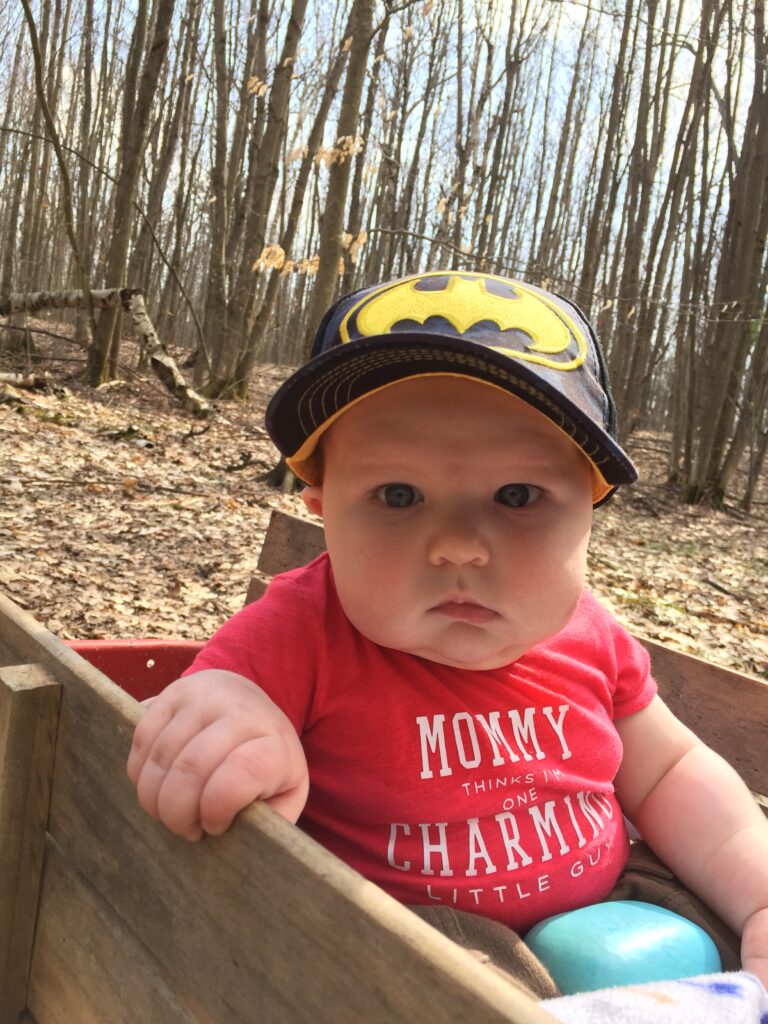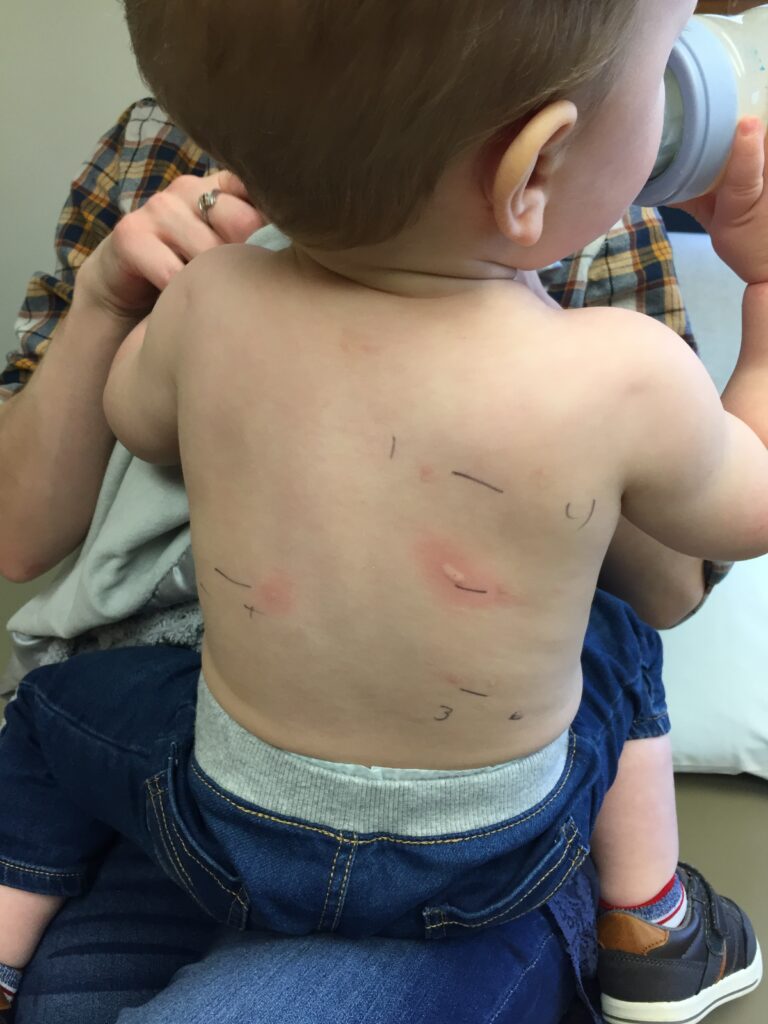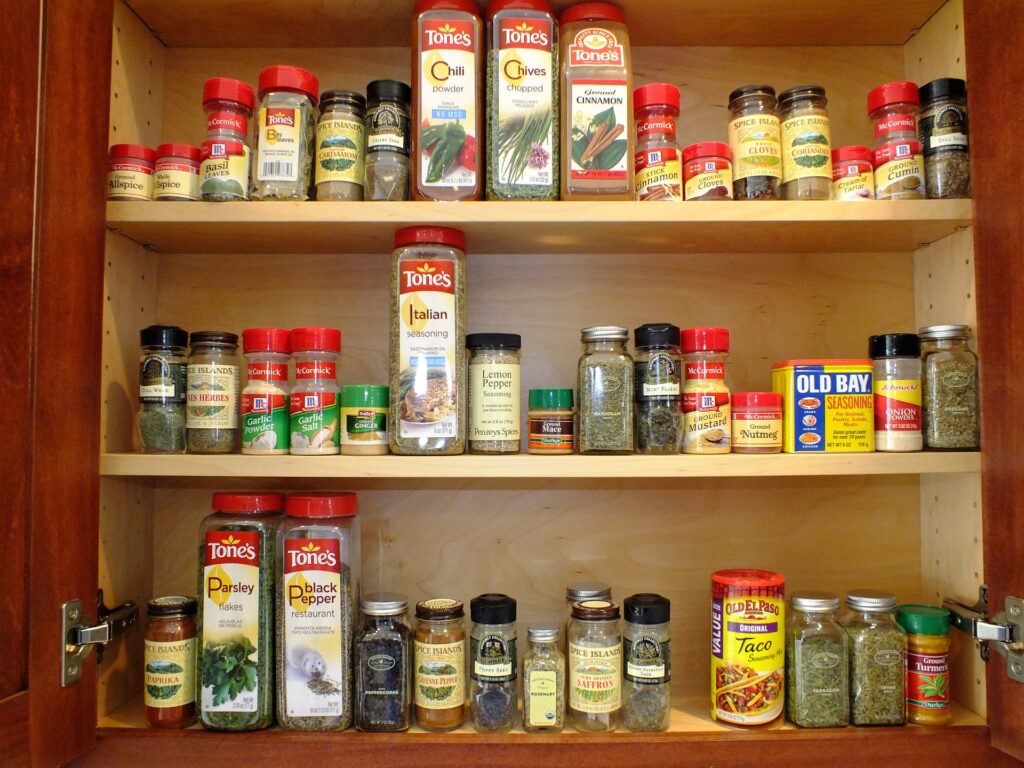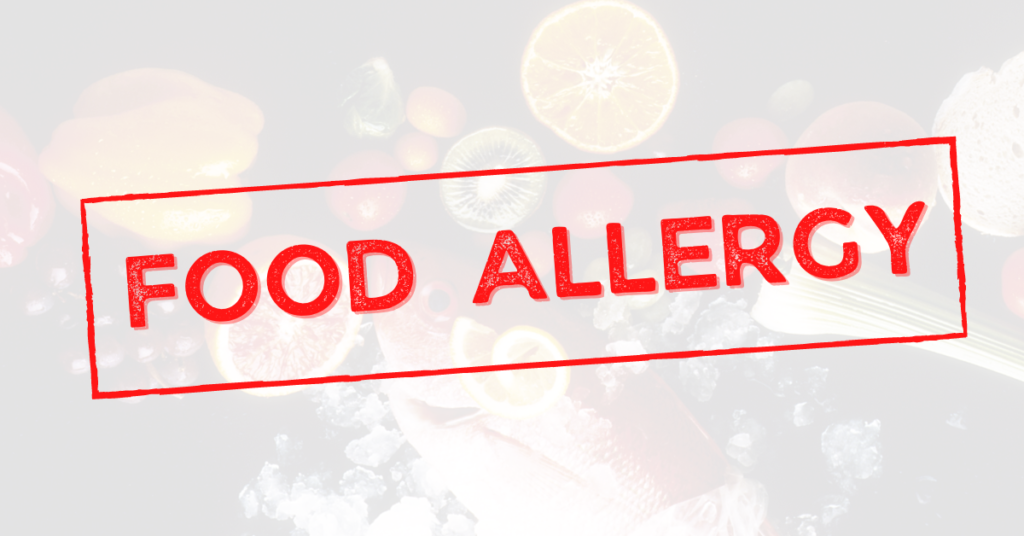In this post, I’m going to provide you with some tips and resources to help you after the discovery of a food allergy in your child. Those first few days can be scary. Your mind is overwhelmed and things can feel like they’re spiraling out of your control. I know, I’ve been there.
I’ll show you how to regain control while coming to terms with a food allergy in your child by showing you:
- The first steps to take to make your home safe for your allergy kiddo
- What to look for on food labels to avoid your allergen
- Where to find allergy friendly foods and some of our favorites
Even if you’re not dealing with a food allergy in your child, there’s some great info you can get from this blog post to help ease into establishing healthier eating habits with your kiddos. If you just want resource ideas on where to get healthier food options for your kids, skip to the end! Otherwise, I’m going to give you the back story of our food allergy diagnosis in the next few paragraphs.
Our Food Allergy Discovery
If you’ve read my guidebook, A Nurse in Your Purse, you’ll know that I have two kids. My first was a breeze when it came to her health. Don’t get me wrong, I was absolutely terrified at being a first time mom and responsible for her entire wellbeing! She proved to be a fairly easy child when it came to any health issues, though. That is, until she turned three and we started dealing with tooth decay, but that’ll be another blog post!
She gave us a false sense of confidence. We thought we were pros at this parenting thing and the second kid would be a breeze.
We. Were. Wrong.
Anyone else fall into that trap?!
I had a healthy, uncomplicated pregnancy with my second and no inkling of what was to come. His issues started day one in the hospital. Within hours of his birth, he woke me up with a blood curdling scream and I found my less than a day old infant choking on his own spit up and phlegm.
It’s not without reason they leave you that little blue suction bulb in the bassinet with your newborn. I hit the call button almost at the same time as I started suctioning out the fluid from my son’s mouth. A moment or two later the nurses came and took over. After a thorough exam they deemed him to be alright and assured me that it was a normal thing that can happen, but I couldn’t get his scream out of my head. Something was just off with it.
He was discharged from the hospital with a clean bill of health a day later, however.
Was It Allergies From The Beginning?
The screaming and spit up continued. Over the next few months, we were constantly alerted by that high pitched scream just before a spit up episode would occur. Sometimes I’d be able to pick him up before it was all over him and his bed. Other times, we changed sheets 3-4 times a night. He was gassy, fussy, and cranky almost every night. We ended up having to prop him 45 degrees in his bassinet when sleeping and he always slept within arms reach of me.

His spit up was never an abnormal color. Nor was it really projectile, and he never had trouble with weight gain, so I knew there was no emergency issue with what was going on with his belly. Some babies just spit up, right? We did all the proper reflux precautions to help, but chose not to do medications. Instead, I watched what I ate to see if there was any improvement. There wasn’t much that I noticed, but at that time, I wasn’t aware how long some foods take to get out of your breastmilk. Looking back, I know I didn’t give it enough time when I chose to cut out different foods. You don’t know what you don’t know, right?!
At about 3 months, the screaming stopped while the spit up episodes continued. But he finally seemed to be coming out of that colicky phase and was becoming a much more contented baby. Although he did continue to spit up after most feedings, it was nowhere near as much as before. This I attributed to overfeeding, but since I was nursing it was hard to tell how much he was actually getting! And truthfully, it’s hard to cut off a nursing babe, isn’t it?! He certainly wasn’t lacking for food, I mean, just look at those rolls!
Allergies And Baby Skin
Around 4 months of age, a rash appeared under his chin right around the same time he became a drooling machine. I assumed he was probably starting to teeth, though I knew we wouldn’t see any teeth pop for a few more months. Seemingly every where his spit touched, he would rash up! I literally thought for a while that my kid was allergic to his own spit.
We tried EVERYTHING to get the rash under his chin to calm down. Working at a pediatric office had its perks, as I had access to all the samples we would give to patients to try. The latest and greatest. We tried them all.
They would work for a time at decreasing the redness, but they never healed it. When he learned how to control his hands, he would just dig at his chin because it was so itchy! To the point it would bleed from his scratching. We switched to dye free and perfume free soaps and detergents. We’d try to keep his chin as free from drool as possible and kept a barrier ointment on it at all times. We’d even avoid being anywhere he might get too hot and start to sweat and changed his bibs numerous times a day. I would even use the Magic Butt Cream we would make in our office on his chin when he was sleeping because it would get so bad, but it still didn’t resolve his rash.
It was like his skin was constantly borderline inflamed. Different spots would break out here or there, seemingly triggered by his spit or any amount of scratching. After the first few months of life, my baby never again had that soft baby skin. It was always bumpy and rough feeling, usually with reddened spots all over. I wish I had known more about the connection between food allergies and skin issues at that time.
And then it seemed to just stop.
The rash under his chin was gone. He still had the roughened skin, but the full blown breakouts were gone for a while. We, of course, applauded our efforts thinking we had anything to do with this miraculous healing. We had a happy, healthy baby boy for a couple of months. Other than his teeth starting to pop through. Otherwise, we enjoyed a short time of having a “normal” baby and thought all his troubles were in the past.
Finally, The Diagnosis Of Food Allergies. The Relief At Answers. The Fear Of The Unknown.
Then the food allergies. We discovered these little gems when we had a birthday dinner for my daughter and she requested crepes. I gave my son a small bite of one and within minutes a few hives popped up around his mouth. I got a washcloth to clean his face, hoping it was just a contact irritation, and then continued to monitor him for a few minutes. His lips started to swell. He coughed. Then he coughed some more. He became a bit fussy, but not overly so. But he kept coughing. And the swelling wasn’t going down.
It was really at this point I remember the mom in me switching off and the nurse taking over. I grabbed our medicine box, looking for liquid Benadryl, but wouldn’t ya know it … I didn’t have any. Some nurse mom I am! The next best thing I had was the chewable form of kid’s Benadryl. Not ideal, but better than nothing. So I broke it in half and crushed one half up in a bowl, put some on my finger and stuck it on his tongue. I did that until the bowl was empty. Thankfully, within about 20 minutes the swelling started to go down in his lips. The coughing began to subside shortly after that as well. I remember deleting the 911 number on my phone that I had typed in, ready and waiting.
My son was 11 months old when we began to avoid egg products with him.
When I look back, I can’t help but thank God that his hand was on my son that day. Food allergies can end so much worse than what ours did. As odd as it may sound, I’m thankful for the reaction we had.

Obviously, we checked in with his pediatrician who sent us to an allergist. Skin testing confirmed the egg as a high allergy … milk came running in just behind it. Ironically enough, I had begun to suspect a milk allergy due to his constant hoarseness when he laughed and issues with stooling. Sometimes an allergy isn’t always as obvious as you think. He had only been on milk for a couple of months because my own milk supply had dried up due to high stress at work. It was during this time that his laugh had seemed to change. I hadn’t stopped giving him milk because, at the time, I felt like it was a huge transition to make without having it confirmed with the allergist. I was afraid I was wrong and would be taking it away for no reason.
Well, now we had no choice. I had my confirmation.
So now, not only was it one food, but two that we were going to cut. I took his milk bottle away right there in the allergists office. Yup, he was drinking milk as he was being tested for a reaction to it.
He never drank milk again. Nor any alternative for it. Oh, we gave them a try. The same day we got his diagnosis we went out and bought coconut milk, almond milk, cashew, soy, rice…. All of the alternatives. He hated every single one. So my then 13 month old drank only water from that moment on.
The First Few Days After Receiving An Allergy Diagnosis
My first grocery shopping trip after the allergy diagnosis took me 3 hours. Just for what I thought were basic things. Which pretty much meant I was buying all new things because everything I used for cooking seemed to contain milk or egg.
I literally remember trying to read the food labels through tear-filled eyes. Constantly checking the list of things to avoid and the alternate names that the allergist gave us, trying to make sure none were on the label of the box in my hand. To say I was SO OVERWHELMED would have been the understatement of the year! I would have given anything to have someone there to walk down the aisle with me and show me what was safe and what wasn’t. What alternatives I could use in place of his allergy food. And what the heck that unpronounceable ingredient was and whether it was safe or not!

Any other allergy mama’s out there? You know exactly what I’m talking about. It’s almost a crushing feeling knowing the daunting task that you now face! The absolute feeling of helplessness and unpreparedness. But you have no choice because your child’s life depends on it. It’s like being stuck between a rock and a hard place.
If you’re new to food allergies then check out the FARE website as it’s a great resource to have onboard while navigating the ins and outs of a food allergy in your child. I wish someone would have told me about this site when my son was first diagnosed! Even our allergist didn’t mention it as a resource. When you’re new to the allergy world, you need all the help you can get.
It’s been a long road since that first grocery shopping trip. As we discovered even more sensitivities with my son as he got older, I had to dive deeper into my search of why foods were reacting the way they were with him. Like what the additives/preservatives were and what they did in the body. Why the allergy friendly versions of foods still gave him issues. This led us to our next level of lifestyle changes. But that’ll be for another post, too. Right now, I want to focus on what to do when you get that initial diagnosis of an allergy in your kiddo.
Please, understand, while I am an RN, I am not an expert when it comes to allergies. I’m not an expert when it comes to all things nutrition wise. I am not an expert when it comes to being a mom. The things I share are from my experience having traveled this road with my kids. Take from it what you can to help you on your own journey. And remember … it’s a journey. You aren’t going to get there in one day or in one shopping trip. So give yourself a little bit of grace and time.
I’ve done a ton of research, a lot of trial and error, and have pinned countless pins in an attempt to find allergy friendly and healthy recipes that not only my allergy kiddo will eat, but also the rest of my family. Because it wasn’t just my son’s diet that changed, it was ours, too. I was already overwhelmed with having to overhaul my entire line of thinking about grocery shopping, cooking, and eating, I was NOT going to be making separate meals for everyone while I was getting the hang of this whole allergy thing. Cross contamination was an obstacle I chose to eliminate. So for a while, we all went egg and dairy free to make life a bit easier on mama.
Clearing The House Of The Allergy Inducing Food
The first step if you’re dealing with a food allergy in your child is going to be getting rid of everything that has that particular offending food in it. For us it was eggs and milk. If you saw an allergist, they should have given you a list of alternate names for the particular allergy you’re dealing with … because it just has to be even more complicated with multiple crazy names for eggs. Or milk. Or whatever the allergy may be! If they didn’t, or if you’re only suspecting an allergy at this point and haven’t seen an allergist yet, you may not have that handy list. If that’s you, head over to the FARE site here and look for the allergy you may be suspecting and they will give you more information on all the different names and the foods it may be in.
Now, if your kiddos allergies fall within the top 8 allergens list (peanuts, tree nuts, eggs, milk, soy, wheat, fish, and crustacean shellfish), then they have to be listed on the label of food if they’re an ingredient. If the product is simply made on the same line as those allergens, it’s completely up to the company itself to disclose that or not. They’re not required to.
If the allergy that you’re contending with doesn’t fall within the top 8 list then it gets a bit trickier. They could be listed under “natural flavors” or “spices”. Honestly, it’s best to avoid them if you see those labels. But if it’s a product you really want, then the only other option is to call the company directly to ask them if it has the allergen in it.
So now let’s break down into bite sized pieces how to remove the offending allergy from your house. Once you read through these steps, you’ll probably say, “Wow, that seemed a bit obvious”. But to an overwhelmed mama’s mind that’s running in a hundred different directions because of a new diagnosis with a kid screaming for the foods they can no longer have because it could be life threatening … Sometimes the obvious is illusive in those moments. So that’s why I’m going to point out the obvious right here.

- Start with ALL your boxed, canned, and packaged products at home in the cupboards and pantry, including products such as gummies, candies, sprinkles, spices, extracts, etc. You truly do have to look at everything.
- Next, look through all your packaged fridge and freezer products. Give them to other family members or donate them, whatever suits you best. If it’s homemade and you’re unsure or can’t remember what was used to make it, get rid of it.
- Next, tackle the household products that you use directly with the person that’s diagnosed with the allergy, as well as any they may come in contact with that someone else in the family uses. Soaps, detergents, lotions, shampoos, perfumes, household cleaners, air fresheners, etc. You’d be surprised how many products contain some of the top food allergens in them.
Now, I’d love to tell you here to just go straight to eating clean, whole foods. No processed foods or allergy friendly alternatives (they’re full of other additives that the body doesn’t need, but that’s another post, too.) I want to tell you to shop only at your local farmer’s market. Go straight to non-toxic products. I’d tell you to do all that in hopes that it’s exactly what you would do. It would be the best choice health wise, but it’d also be the fastest way to make you give up, to be honest. Instead of easing in with baby steps, it’s more like jumping head first into the deep end of a pool without knowing how to swim. Not the way I recommend if you’re already feeling overwhelmed. Which is why I give you baby steps to start with!
So once you’ve cleared the house of the allergy offending foods, you may decide you want to replace them with an allergy friendly alternative. If you’re really ready to dive in and want to skip this step, then re-read the paragraph above! Taking that leap can be tough. And if your kiddo is the affected one, prepare for an uprising! Sometimes transitioning them to an alternative that is allergy safe for now is better than cutting them off cold turkey. There will be time to ease them off the processed foods, should you choose to, once you’ve gotten a handle on the allergy part. (Journey, remember?!)
Replacing these products will be different, however, depending on what the allergies are, so unfortunately, I can’t give you a cut and dry list right here. I can give you some great sites, however, that have compiled some allergy safe foods and companies in one convenient spot.
Here’s three to help start you on your search.
- https://www.chla.org/sites/default/files/atoms/files/CHLA-Allergen-Friendly-Food-Manufacturers.pdf
- https://snacksafely.com/safe-snack-guide/
- https://community.kidswithfoodallergies.org/db/allergy-friendly-foods
If your allergy happens to be eggs or milk, I can point you in the right direction for substitutes of those items when baking or cooking. This post by The Kitchen Whisperer is a great one for egg replacements. For milk, this post by Vegan Nutritionista breaks it down nicely on the differences between all the milks. But a simple Pinterest search for a replacement for your allergy food will help you get started.
Our Favorite Allergy Friendly Packaged Snacks
As I mentioned before, we actually don’t do a lot of the packaged allergy alternatives any more. As we’ve learned more about healthy eating and living, we’ve actually chosen to cut most of them out because of their own additive issues. But we still do some select packaged foods. I typically try to stick with unprocessed foods as snacks with my kiddos, but sometimes it’s just easier to grab something that’s already made, especially when we’re on the go!
When we first started shopping for some of these items, my jaw dropped at the price of them. Knowing they aren’t full of chemically processed ingredients that are more harmful to my kids is worth it to me, however. A simple google search will show you that there are many studies now linking all sorts of childhood issues with the junk foods that kids these days have access to, along with long term health issues later in life.
I found that when we buy items like the jerky and pair it up with cheese, it’s a more filling of a snack for them anyways. This means I don’t have to use as many snacks to get them by until the next meal. Which means I’m buying less snacks. So in the end, it ends up being closer in cost than you may realize.
The list below is some of our favorite packaged snacks for my kiddos. I’ve included my affiliate links (read the full disclosure here), but don’t be afraid to shop around to find good deals and sales on these items, either online or in stores. I’m all about saving where you can. These are to give you ideas on what you can use with your kiddos that are healthier snack options. Our allergies are milk and egg, but I still always try to make sure the ingredients list I give them on any packaged product is very short so these will probably work very well for some of you with different allergies as well.
- That’s It Fruit Bar
- Ekoa Fruit Bar
- EPIC Wagyu Beef Steak Strips Grass-Fed – Jerky
- Larabar Peanut Butter Cookie (they also have a variety pack to try different flavors)
- Bear Real Fruit Yoyo’s (it’s a fruit roll up)
- EPIC Venison Sea Salt & Pepper Bars – Jerky
- Bare Baked Crunchy Banana Chips

There is one thing I feel like I have to mention about transitioning off of conventional processed foods or to the allergy friendly variations. There’s going to be some push back from the kids. No matter what. These foods have different textures and smells than what they’re used to, depending on what age you start them at. Kids can have a hard time with change. Unfortunately, with allergies, you don’t have as much wiggle room or transition time as it becomes a matter of safety with the foods they are ingesting. But it’s doable, I promise. We’re living proof! (If you’re struggling with this part, please message me or comment below. I’m always happy to talk through some different approaches and food swaps to start with! You can download my free PDF for 8 easy food swaps for ideas.)
Helping kids transition to healthier eating
If you’re not battling a food allergy in your child and are simply wanting to get healthier food items into your kids diet, then you do have time to transition. Switch out just one food at a time, such as Oreos for a Larabar. Then move on to another food. You know your kids best and how much change they can handle. Take it slow if you need to. Give some extra snuggles when they melt down about the change, acknowledge that it can be hard, discuss why it has to be done if they’re old enough to understand that, but don’t undo the change. Don’t cave into going back to the other food. Once you’ve decided on a change for your family, stick with it.
Be sure to always get excited about trying a new food. This helps them get excited about it, too. And don’t worry if you have to try multiple different flavors of something until you find one they like. I’m pretty sure we tried ALL of the Larabars at least three different times before they finally liked a couple of the flavors. If you find one day they like a certain kind of food and the next day they decide they don’t, don’t fret! This is normal. So don’t let yourself get frustrated when things have to change up as far as flavors go.
To help with the whole food changing process, I would often (and still do) tell my kids that they had to try at least a no thank you bite. I’d also tell them that I was going to offer it to them again at some point, even if they didn’t like it with that no thank you bite. I’d tell them that they may not like it the first time they try it, or the second time, but maybe the third time they will.
By using this approach with them, they’ve found many foods they love now that they didn’t like before, and there was very little fuss about it. Honestly, it’s no longer a struggle to get them to try the new foods and they’re actually excited about discovering something new and tasty. Just for reference, my kids were 3 and 6 when we started this approach, so it’s never too late to start!
The transition into the food allergy realm can be daunting, exhausting, and overwhelming. Allergies suck. It makes simple things tough. Going out of the house becomes a full on production as you feel like you have to pack the kitchen every time. Eating out becomes a methodical, planned out event, instead of a spur of the moment thing.
But with all things, you can choose to rise up to the occasion and continue to live life to the fullest. And the great thing is, you don’t have to do this alone, and you’re not the only one to go through this. I’d love to know if you’re dealing with a food allergy in your child and what your biggest struggle is. I also suggest looking into social networks for allergy groups and you’ll find a whole network of other mamas that know exactly what you’re going through. Having that community can make the whole journey a bit easier to travel. And if you’ve been traveling this road for a while and have the hang of it, leave a piece of advice for other mamas. We can all benefit in the knowledge of those that have gone before us.



2 thoughts on “Tips And Resources After Discovering A Food Allergy In Your Child”
A journey, for sure and tho I didn’t deal with this as a mom with children, I’m now dealing with it every day, every day – for myself, for the last 7 years.
I pack a lunch to go out on trips, stick fruit in a bag in the car lest I get tempted to sway away and suffer the consequence!
This is very comprehensive ☺️
Thank you ❤️
You’re most welcome! I hope you find some new snack ideas from the list!